Quick search
CTRL+K
Quick search
CTRL+K

Philadelphia is one of the historically important cities of the United States, and it was even the capital of the country in the years 1790-1800. In the town of the Delaware River, there are countless sights and lots of early American history that give intriguing impressions from the time around the American Revolution.
It was in Philadelphia that the American Declaration of Independence of Great Britain was adopted, and in that way the city has a special status in the history of the United States. This can be looked at in more detail in Independence Hall, which formed the setting for both the declaration and for the adoption of the US Constitution.
Philadelphia is also much more than early American history. In the modern city center there are some of the country’s tallest buildings outside New York and Chicago, and here are several interesting museums with everything from French Impressionists to exciting natural history.
With the city’s location on the east coast, there are many excursion options from Philadelphia. You can, for example, go to New York to the northeast and Washington DC to the southwest and reach both in a short time by train or car. The entertainment in Atlantic City is also close by and you can also experience parts of the British colonial history around Philadelphia.
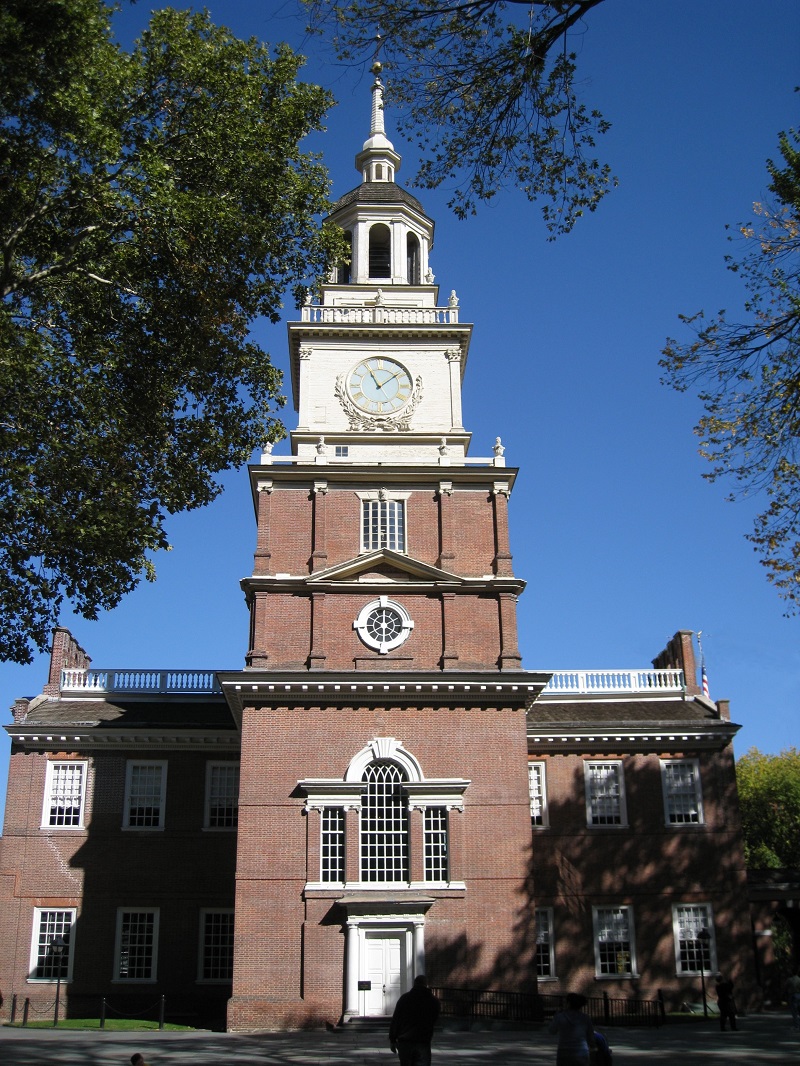
Independence Hall is one of the most important buildings in the United States in relation to the country’s independence. It was here that the American Declaration of Independence and the American Constitution were debated and adopted. Built as the Pennsylvania State House in 1753, the building is today part of the Independence National Historical Park and included in UNESCO’s World Heritage List.
The history of the building started in 1729, when proposals were made for the construction of a so-called state house in Pennsylvania. Andrew Hamilton found a suitable location and this was approved in 1733, after which construction began. The architecture was Georgian with a central tower 51 meters in height and two wings connected to the main structure by arcades. It was Andrew Hamilton and Edmund Woolley who designed the house.
From May 10, 1775 to March 1, 1781, the Pennsylvania State House was used as the primary meeting hall for The Second Continental Congress, where representatives from the thirteen British colonies in North America met. On June 14, 1775, the participants of Congress named George Washington Commander-in-Chief of the Continental Army, they launched the colonies’ own currency, and they signed the American Declaration of Independence on July 4, 1776. The signing took place in The Assembly Room, which is still preserved.
The Pennsylvania State House became Independence Hall, and over the years several structural changes were made to the historically important house. Ownership also changed from the state of Pennsylvania to the city of Philadelphia in 1816, and in the late 1800s the exterior of the building was largely restored to earlier times, while the original interior was recreated in 1948.
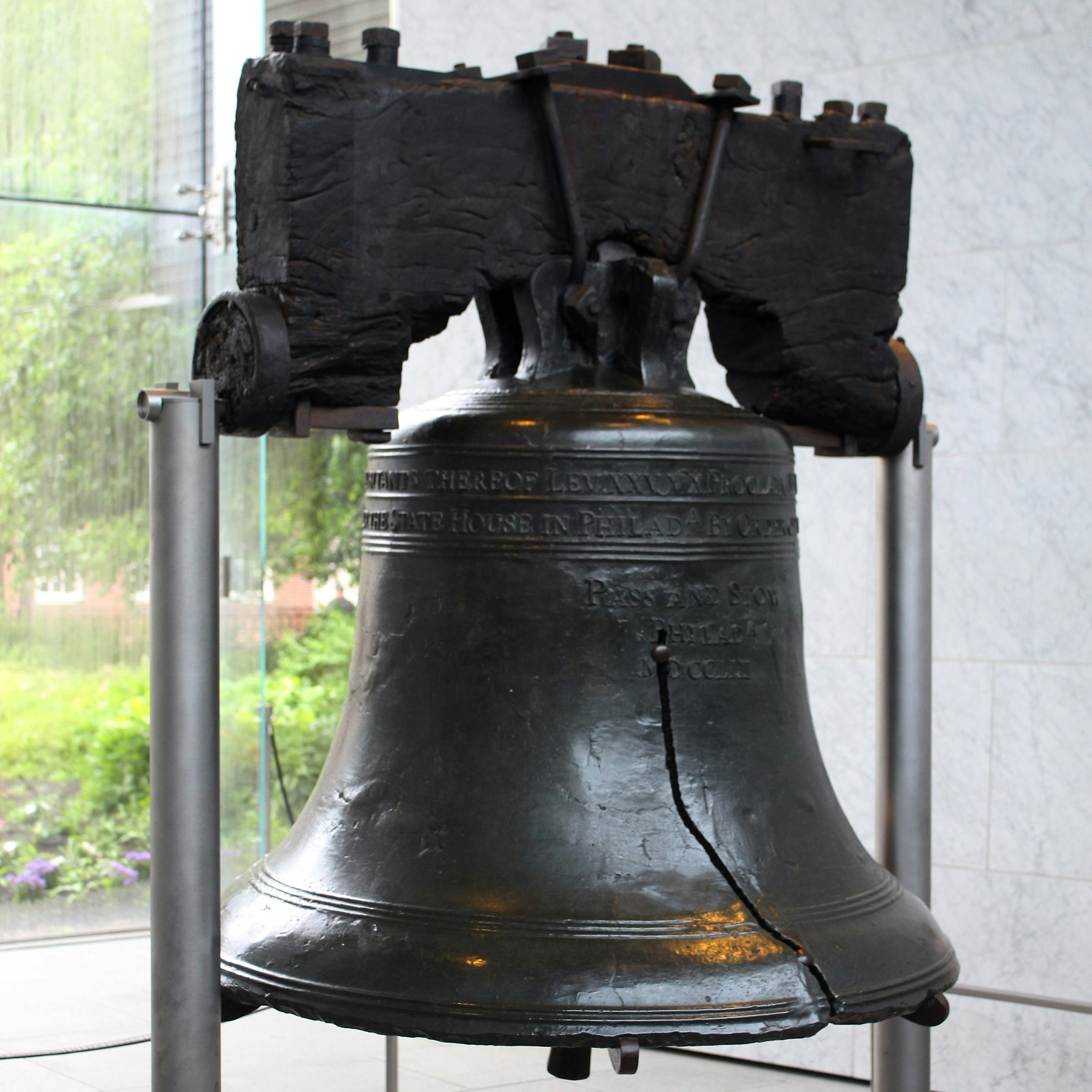
The Liberty Bell is one of the symbols of American independence and thus of the country of the United States. The bell was cast in London in 1752 for placement in the tower of the Pennsylvania State House. Today, it has been moved to the Liberty Bell Center, part of Independence National Historical Park. The bell is believed to have rung in the days after American independence, and from the 1830s it was used as a symbol for the abolition of slavery in the United States.
The bell was formerly called the State House Bell and broke when rung after its arrival in Philadelphia. Twice it had to be recast by locals John Pass and John Stow, whose surnames appear on the bell. In the early years, the bell was used to summon legislators to legislative sessions and to alert the townspeople to public meetings and various proclamations.
Although there is no definite record of the State House Bell ringing at the events of the American Declaration of Independence, it is believed to have been one of the bells rung. After American independence was achieved, the bell fell into relative disrepair until, in the 1830s, it was adopted as a symbol by abolitionist societies, who dubbed it the Liberty Bell.
Today, the Liberty Bell is on display in front of Independence Hall in the Liberty Bell Center, and you can see a crack in it. It came in the early 19th century and grew later, partly because over the years and up until 1915 the bell was often transported around to various exhibitions and events.
Museum of the American Revolution is a museum where you can experience the exciting story of the American Revolution, which took place in the years 1765-1783. The revolution was a revolt in the thirteen British colonies in North America that ended up forming the United States as a new nation. There are lots of interesting things in the nice collection.
The museum opened in 2017 in the building designed by Robert A.M. Stern Architects. A visit follows a chronological journey from the roots of the American conflict in the 1760s to the later armed resistance against the British, the Declaration of Independence from 1776 and the last years of the Revolutionary War. There are many historical highlights such as a replica of Boston’s Liberty Tree, the recreation of an Oneida Indian council, and a version of Independence Hall.
In the museum’s exhibition, you can see an iconic surviving artifact from the revolution, General George Washington’s tent, which formed his headquarters. In this way, it served as both his office and sleeping quarters throughout much of the War of Independence. There are also other of George Washington’s belongings as well as letters, books, weapons and much more from the time.
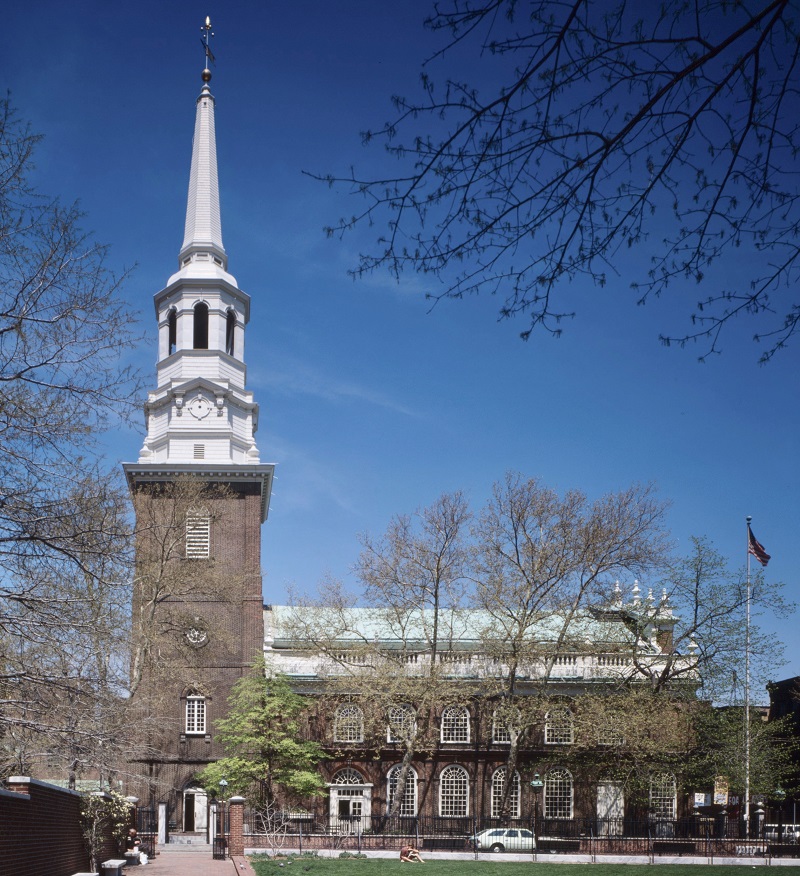
Christ Church is a church founded in Philadelphia in 1695 as part of the Church of England. The current church was built 1727-1744 with completion of the tower 10 years later. From 1754 to 1810, the 60 meter high tower was the tallest building in today’s United States. The church interior is beautiful and it was here that William Penn was baptized. The baptismal font came from All Hallows-by-the-Tower in London and is still in use. The congregation also counted George Washington, Benjamin Franklin and others from the time of the American Revolution.
Christ Church stands as one of America’s most beautiful 18th-century buildings and as a fine example of Georgian architecture. The architect is unknown, but the church was modeled after Christopher Wren’s many famous works in London. The design has a symmetrical, classic facade with arched windows and a simple but elegant interior with columns and wooden pews for the churchgoers.
Carpenters’ Hall is a building that was constructed 1770-1774. The building went down in American history as the place where the first Continental Congress of American colonies met after the British blockade of Boston Harbor. It was also here that the colony of Pennsylvania proclaimed its independence as the Commonwealth of Pennsylvania.
Carpenters’ Hall is part of the Independence National Historical Park, which consists of several sites in Philadelphia with historical significance to American independence from the British Empire. The building’s name comes from the builder and owner, the Carpenters’ Company of the City and County of Philadelphia, which is the oldest craft guild in the United States.
The plot of land for the construction of Carpenters’ Hall was acquired in 1768, and the building was designed by Robert Smith, who designed Carpenters’ Hall in the Georgian style with inspiration from Palladian style from Italy. The Carpenters’ Guild held its first meeting in the still-unfinished building in 1771. The First Continental Congress used the building, the Pennsylvania State House being used for the colony’s assembly.
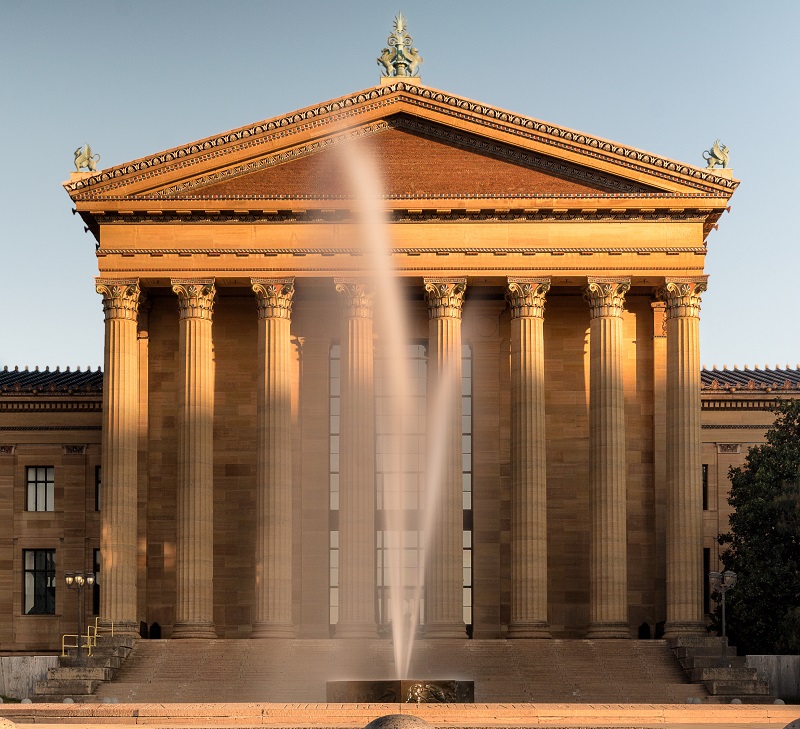
The Phildelphia Museum of Art is an art museum that was established at the celebration of the United States’ first centenary of the country’s Declaration of Independence. It was in 1876, and in the wake of the Centennial Exhibition, a museum was formed. The museum’s current neoclassical main building was built 1919-1928 on the ridge of Fairmount, which rises significantly above the Schuylkill River.
At the museum you can see art from all over the world, and here is everything from ancient works to recent art by well-known artists. There is a fine Asian collection at the museum, including paintings and sculptures from Japan, China and India, Chinese porcelain and Persian rugs. You can also see European works from the Middle Ages to the present day, and this collection represents, for example, French impressionism and post-impressionism.
There are interesting things to see around the museum as well. The eastern steps from street level to the museum are called the Rocky Steps because Sylvester Stallone ran up them in the 1976 film Rocky and raised his arms in triumph at the top of the steps. In the area in front of the museum, you can see the city’s famous statue of Rocky from the movie Rocky III. You can also go behind the museum and see the Fairmount Water Works, which was built in neoclassical style along the Schuylkill River in the 1800s.
Barnes Foundation is an art museum that is home to one of the world’s largest collections of French Impressionism, as well as Post-Impressionist and other works. The collection consists of 181 works by Renoir, 69 by Cézanne, 59 by Matisse, 46 by Picasso and 7 by Van Gogh. There are also works by, among others, Peter Paul Rubens, Titian, Paul Gauguin, El Greco, Francisco Goya, Édouard Manet, Jean Hugo and Claude Monet.
The Barnes was established in 1922 by Albert Coombs Barnes, who made a fortune assisting to develop the product Argyrol. Albert Barnes began collecting art in 1902, and over the following decades he acquired many works on trips to mainly Paris. The Barnes was founded more as a school and educational institution than as the excellent museum visitors encounter today.
Elfreth’s Alley is a narrow street with cobblestones, which is the oldest residential street in the United States. The old environment is maintained in the middle of the modern city, and here are two houses with the numbers 124 and 126 from 1755, which today are open as a museum with the name Elfreth’s Alley Museum.
The street is located in the Old City district and was established in 1703. There are a total of 32 houses on the street and they were built between 1703 and 1836. The architecture is typical of Philadelphia of the time with the Georgian style and the Federal style being a type American classicism. You can also see several so-called Trinity Houses, which are small narrow houses with typically three floors.
Elfreth’s Alley is named after Jeremiah Elfreth, who was a blacksmith and landowner. Different people lived in the street, mainly tradesmen and their families, including ship carpenters, silversmiths, tinsmiths, glassblowers and furniture makers. Around the street small industries arose from the end of the 1800s, but the environment in Elfreth’s Alley was preserved.
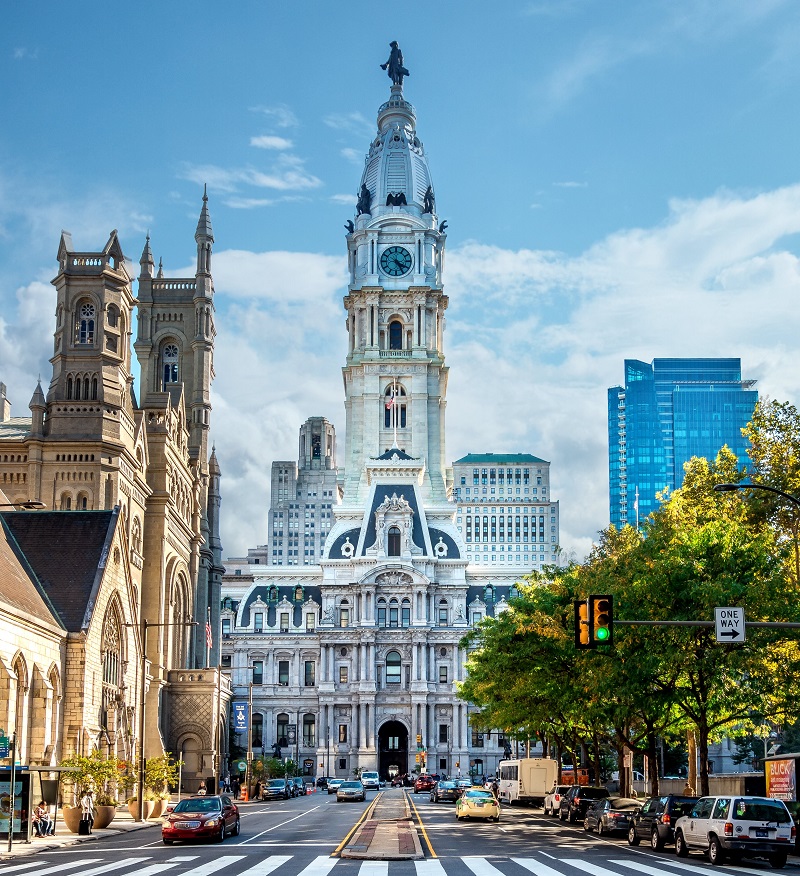
City Hall is Philadelphia’s seat of the city government and administration. The impressive building was constructed in the years 1871-1901 in a stately Napoleon III style. The town hall tower is 167 meters high, and at the top stands a statue of the city’s founder, William Penn.
It was the architects John McArthur Jr. and Thomas U. Walter, who designed City Hall, which opened as the tallest building in Pennsylvania, which it was until 1932. In fact, City Hall was planned to be the tallest building in the world, but during construction, the Eiffel Tower and the Mole Antonelliana, among others, were completed with larger Heights.
Philadelphia City Hall was built with a beautiful decoration. In addition to the statue of the city’s founder, William Penn, the approximately 250 other sculptures are artists, engineers and others who over time contributed to the development of the United States and stood for American ideals. You can also enjoy the beautiful building and large parts of Philadelphia from the observation deck of the City Hall tower at a height of 150 meters.
The famous writer Edgar Allan Poe lived in several places in Philadelphia in the years 1837-1844. The Edgar Allan Poe National Historic Site is a museum located at 532 N. 7th Street, the only one of his residences in the city that survives today. He rented the place here from early in 1843 and he lived here for about a year.
Poe lived in at least four different places in Philadelphia, including on Arch Street, on 16th Street, and on Coates Street. While the author lived in the city, he published some of his best-known works such as The Tell-Tale Heart, The Murders in the Rue Morgue and The Gold-Bug.
At the museum you can learn about Poe’s life, contemporaries and works. You can also see a room that is decorated in the style of the 1800s. However, the room and the other furnishings in the museum have nothing to do with the residence in Edgar Allan Poe’s time.
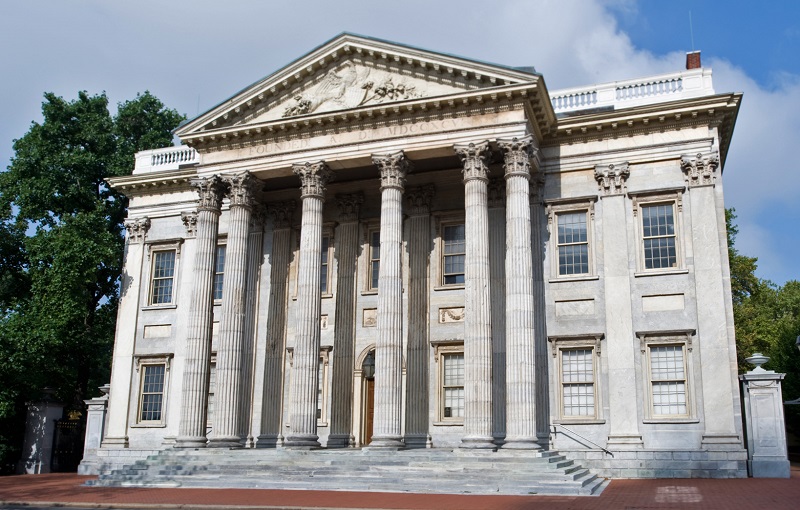
In 1791, the US Congress voted to establish an American National Bank, and its headquarters opened in this classicist building, which was completed in 1797 as the First Bank of the United States. In the years before, the Bank of North America had functioned as a national bank, but formally the institution was not established until the resolution of 1791.
The difference between the new bank and other banks was that First Bank of the United States had to have branches in several American states. The establishment of the bank happened as part of Chancellor of the Exchequer Alexander Hamilton’s financial innovations. In addition to the national bank, the other measures were an assumption of the state’s war debt by the United States government, the establishment of a mint, and the imposition of a federal excise tax.
The First Bank of the United States was established in Philadelphia, which was the capital of the United States in the 1790s. The bank started its operations in Carpenters’ Hall, before the new bank building was completed in 1797 in the Greek style to the designs of architects Samuel Blodgett and James Hoban.
The Second Bank of the United States was a bank that President James Madison established in 1816 as America’s second national bank. The First National Bank had operated on a 20-year contract from 1791 to 1811. In the wake of the War of 1812, the federal government suffered from the disorder of an unregulated currency and a lack of fiscal stability, and the interdependence of industrialization and finance provided support to a national banking system.
The bank was housed in a new building that was completed in 1824. The architect was William Strickland, who designed several buildings inspired by classical Greece. The bank ceased its original function in 1841, and today it is used as a gallery with portraits of important people in the early United States. It is in the People of Independence exhibition, which gives an insight into the present, and here portraits by the artist Charles Willson Peale are the core of the collection.
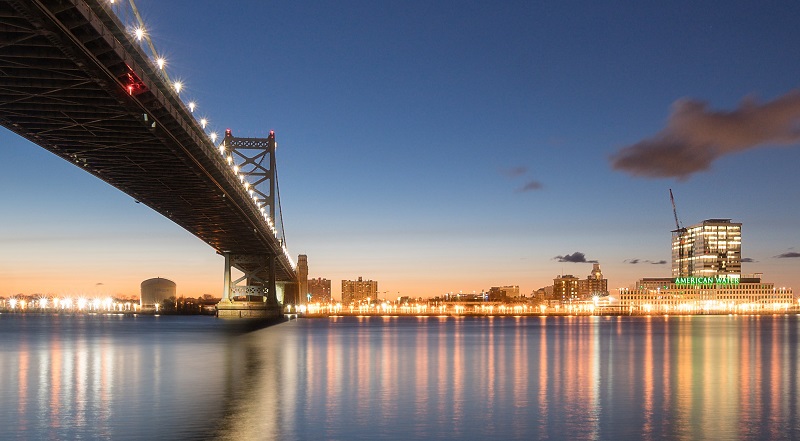
Benjamin Franklin Bridge is a large suspension bridge that opened in 1926. It connects Philadelphia, Pennsylvania with Camden, New Jersey. The bridge is a total of 2,917 meters long, and it crosses the Delaware River with a longest span of 533 meters. The first three years of the bridge’s life span was the longest in the world.
There were already plans for a permanent connection across the Delaware River in 1818, and throughout the 19th century many proposals for various bridges appeared, but none of them were realized. In 1919, a commission was established to find a solution, and construction of the Delaware River Bridge, which changed to the current name in 1955, began in 1922.
Since opening, several connections have been established across the river from Philadelphia to southern New Jersey. You can also take the PATCO Speedline train across the water on the Benjamin Franklin Bridge, which was actually built with streetcar rails that were never used.
Parkway Central Library is a beautiful library building that opened in 1927. The building was designed by Julian Abele in Beaux-Arts style. It is the main library of Philadelphia, and there are many interesting and valuable books and manuscripts in the collection, which includes The Rare Book Department.
The Rare Book Department features Charles Dickens’ collection of first editions, personal letters and Dickens’ stuffed raven, Grip. There is also Americana, Beatrix Potter, early children’s books, works by Edgar Allan Poe and a large collection of European manuscripts from the 11th to the 16th centuries.
The Bourse Food Hall is a vibrant place of restaurants and bars in downtown Philadelphia. It is housed in the city’s former stock exchange, which was built 1893-1895. The beautiful building obviously no longer functions as a stock exchange, but instead you can enjoy the historical setting over a meal.
It was George E. Bartol who founded the stock exchange in Philadelphia in 1891, with Hamburg’s stock exchange as a model. Bartol had been inspired in Europe the year before, and he organized Philadelphia’s business life to invest in the creation of the stock exchange. After this, the stock exchange building was designed by G. W. & W. D. Hewitt and built in redstone and terracotta.
The National Constitution Center is a center and history museum whose focus is the US Constitution. The center was built from 17 September 2000 and opened on 4 July 2003, and since then various object and exhibitions have told the story of the constitution and created dialogue around it. You can visit a hall with models of the signatories of the American Constitution, who made the historic signing on September 17, 1787.
It was politically decided in 1988 to establish the center and museum to create knowledge and understanding of the US Constitution among Americans. It was also decided that the center should be located as part of the Independence National Historic Park in Philadelphia, where, together with the Independence Hall and Liberty Bell, it could form a unified center for the history of American independence.
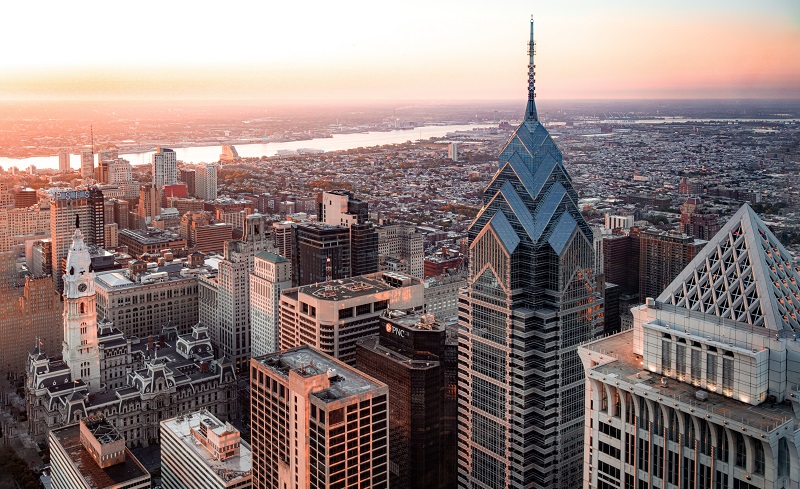
One Liberty Observation Deck is a place on the 57th floor of the One Liberty Place building where you can enjoy a fantastic view of Philadelphia and the surrounding area. The whole city lies at your feet, and you can follow the course of the Delaware River and see the state of New Jersey.
One Liberty Place is one of two distinctive skyscrapers that together form the Liberty Place complex. One Liberty Place is 288 meters high, while its sister building Two Liberty Place is 30 meters lower. Construction took place between 1985 and 1987, and in terms of height, the high-rises were the first in the city to surpass the William Penn statue on top of Philadelphia City Hall.
Gloria Dei Church is a church also called Old Swedes’, which comes from the fact that the church was built as a Swedish church in the years 1698-1700. It is the oldest church in the state of Pennsylvania. Around the church there is a cemetery, where Sven Gunnarsson is one of those buried. Gunnarsson was a founder of New Sweden along the Delaware River in the middle of the 17th century.
After the founding of New Sweden, the Swedes built churches, The first one was Holy Trinity Church in Wilmington, Gloria Dei Church became the second Swedish church in the colony. The settlement was established in 1677, and in the first years services were held in another building that was not built as a church.
Gloria Dei Church made history in 1703 as the first place in America where a Lutheran ordination was held. It happened when Justus Falckner was ordained a priest. In the church you can see a fine interior with various decorations such as models of Fogel Grip and Kalmar Nyckel, which were the first Swedish ships that arrived to New Sweden.
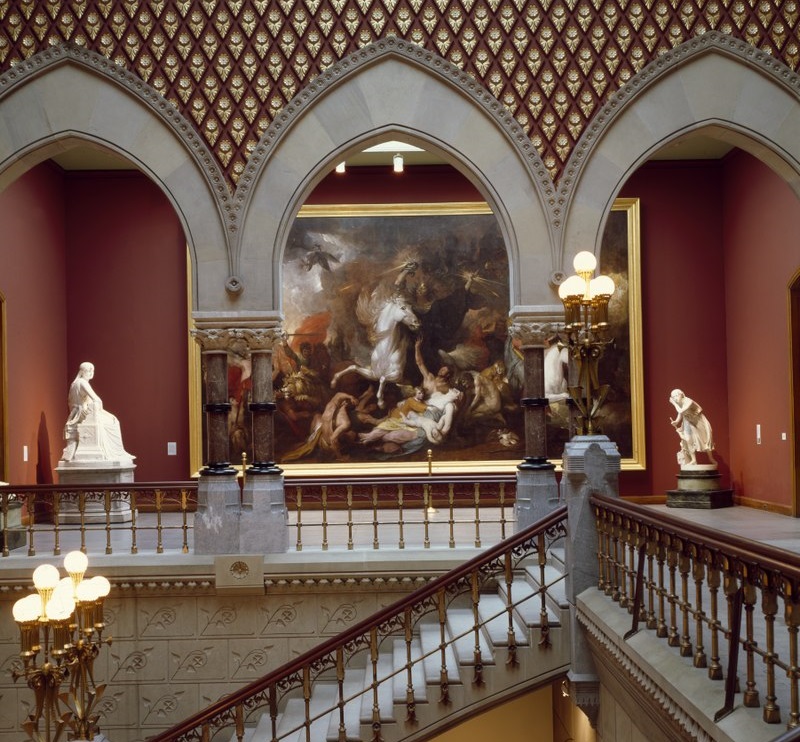
Pennsylvania Academy of the Fine Arts is an art academy in Philadelphia. It is the oldest of its kind in the United States, and its museum is the oldest art museum in the country. Over the years, the museum has built up a very fine collection of American works, and you can enjoy works by Edward Hopper, Winslow Homer and Kehinde Wiley, and you can see one of Gilbert Stuart’s well-known portraits of George Washington.
The academy was founded in 1805 by, among others, the artists Charles Willson Peale and William Rush, and the museum was established two years later. The first exhibition took place in 1811, where visitors could see over 500 paintings and sculptures. Today, you can enjoy the museum’s exhibits in the Furness-Hewitt Building from 1876, which is considered one of America’s most beautiful Victorian buildings.
Comcast Technology Center is an office building with a height of 342 meters. It opened in 2018 as the tallest building in the United States outside of the two classic skyscraper cities, New York and Chicago. There are 60 floors in the high-rise, which has a hotel and a restaurant at the top, and from here there is of course a magnificent view.
It was Foster and Partners who were the main architects of the high-rise, which is described as a super-tall skyscraper, as it is over 300 meters. The construction includes five tanks of 125,000 liters of water, which are placed on the 57th floor as a countervailing force on windy days to reduce swaying of the upper part of the building.
The Wells Fargo Building is one of Pennsylvania’s classic skyscrapers from the first half of the 20th century. It was built in 1927-1928 with the name Fidelity-Philadelphia Trust Company Building at a height of 30 floors and 123 meters. It was the architectural firm Simon & Simon who designed the building in Beaux-Arts architecture.
The Wells Fargo Building is one of the numerous skyscrapers built in Philadelphia in the early decades of the 20th century. In the 1920s, among others, the Aldine Trust Building, Lewis Tower, Drake Hotel, Ben Franklin House and Rittenhouse Plaza were built, and high-rise construction continued in the 1930s with, for example, the PSFS Building from 1932, which was the first skyscraper in the USA in the international style.
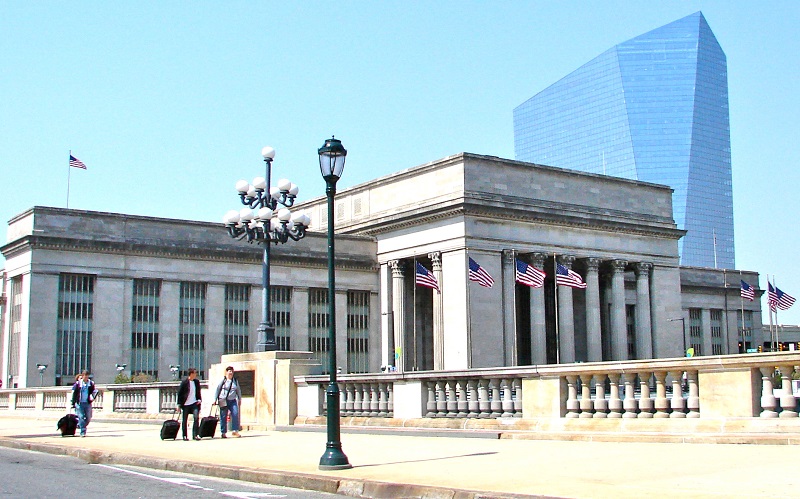
30th Street Station is a large railway terminal that opened in 1933 and it serves as Philadelphia’s main train station. There are many beautiful details in the building, such as the Art Deco-style promenade and Walker Hancock’s sculpture Angel of the Resurrection, which was produced in 1952. You can also see the artwork Spirit of Transportation, which dates from 1895.
The station’s history began when the Pennsylvania Railroad acquired tunnel rights from the Schuylkill River to 15th Street in exchange for land the city needed to build the Benjamin Franklin Parkway. The exchange made it possible for the company to build both Suburban Station and 30th Street Station, which, unlike a previous railway station on the site, had continuous platforms for trains between New York and Washington.
The Franklin Institute is a scientific institution and museum with interesting exhibits in various fields of science and technology. There are both permanent exhibitions and changing themes, and then you can also see the Benjamin Franklin National Memorial with a 6 meter high marble statue of Franklin, who was one of the so-called Founding Fathers of the United States.
The institute was established in 1824, and in time the Franklin Institute Science Museum opened, which is the best-known part of the institution. At the museum you can see several themed exhibitions such as The Franklin Airshow with the Wright brothers’ Wright Model B. This is also where you can see The Giant Heart, The Train Factory and much more.
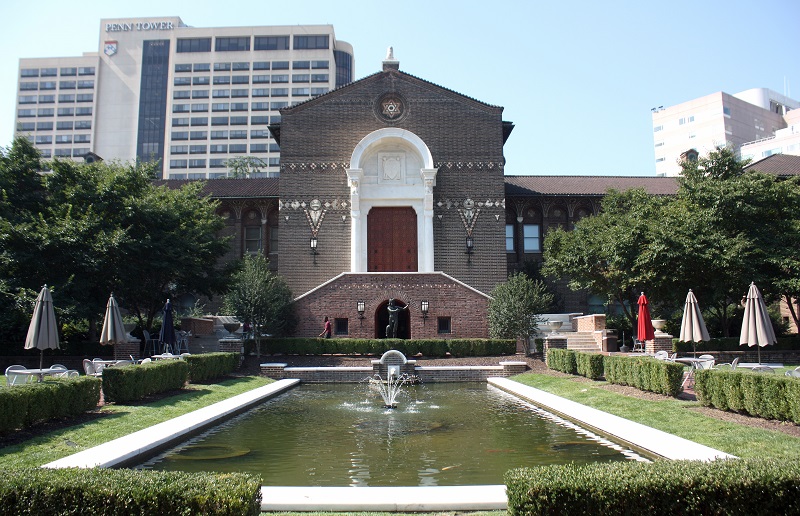
Penn Museum is an archaeological and anthropological museum belonging to The University of Pennsylvania. The forerunner was called the University of Pennsylvania Museum of Archeology and Anthropology, and it was founded in 1887 after an archaeological expedition to present-day Iraq. Over time, the university has led numerous expeditions over large parts of the world and thereby built up an interesting collection.
Over the years, the collections at the Penn Museum have expanded significantly through various purchases. You can see artifacts from East Asia, America and the Near East. Today you can visit galleries with things from the ancient world around the Mediterranean, Egypt, the Near East, Mesopotamia, East Asia and Mesoamerica. There are also artifacts from the indigenous peoples of Africa and Native America.
Boelson Cottage is a cottage built around 1680 and it stands as Philadelphia’s oldest surviving building. The cottage is located in Fairmount Park and was built in Swedish-Dutch style. The name comes from John Boelson, who was granted the plot of land here in 1677.
The cabin is located on the west bank of the Schuylkill River on the 40-acre parcel of land granted to John Boelsen by the Swedish Colonial Court in Upland, Pennsylvania. Today, the cabin is located in Fairmount Park, the largest public park in Philadelphia.
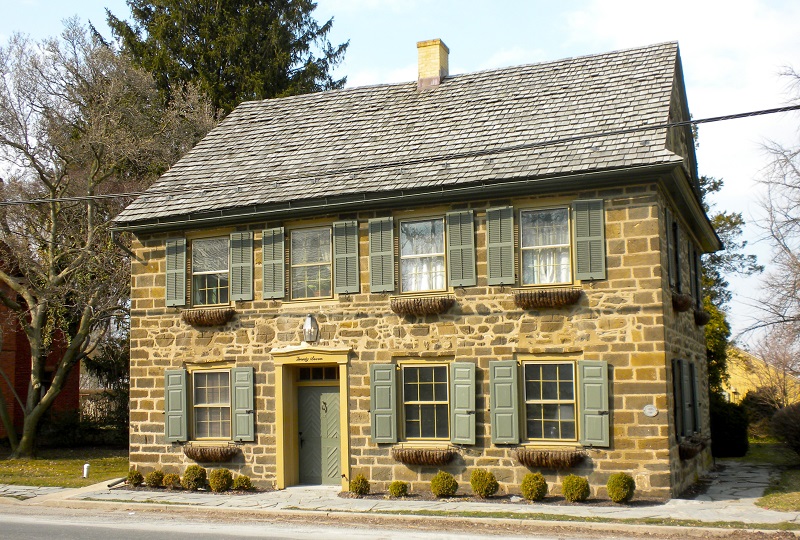
Strasburg is a provincial town with several interesting sights and a cozy atmosphere with many old houses. The city is relatively modest in size, but known as a stronghold for the Amish people in the so-called Pennsylvania Dutch Country. You can see the Amish farms in the countryside and visit the cultural heritage museum The Amish Village.
Strasburg originated around 1750 and was named after Strasburg in what was then Germany. It is also known today as ‘Train Town USA’ due to several railroad related attractions in and around Strasburg. For example, you can explore railroad history at the Railroad Museum of Pennsylvania with exhibits of steam and diesel locomotives. You can also take a trip on the vintage Strasburg Rail Road.
Valley Forge National Historical Park is an area where American Continental Army soldiers wintered from December 19, 1777 to June 19, 1778, and at first it was under harsh conditions. George Washington’s army suffered losses of about 2,000 soldiers through the winter, when British troops had cut off the American army from important supply lines.
The national historical park was established on July 4, 1976, and in the 1,403-hectare area you can see restored historic buildings such as iconic log cabins and monuments erected by the states from which the continental soldiers came. There is also an interesting visitor center and museum that provides an introduction to the American Revolution and the Valley Forge camp.
One of the best-known attractions in the park is the restored colonial home that was used by General George Washington as his headquarters during his stay at the camp. The house is beautifully restored, just like the old Valley Forge railroad station. You can also see the headquarters of other generals from the Continental Army such as those of Huntington, Varnum, Lord Stirling, Lafayette and Knox.
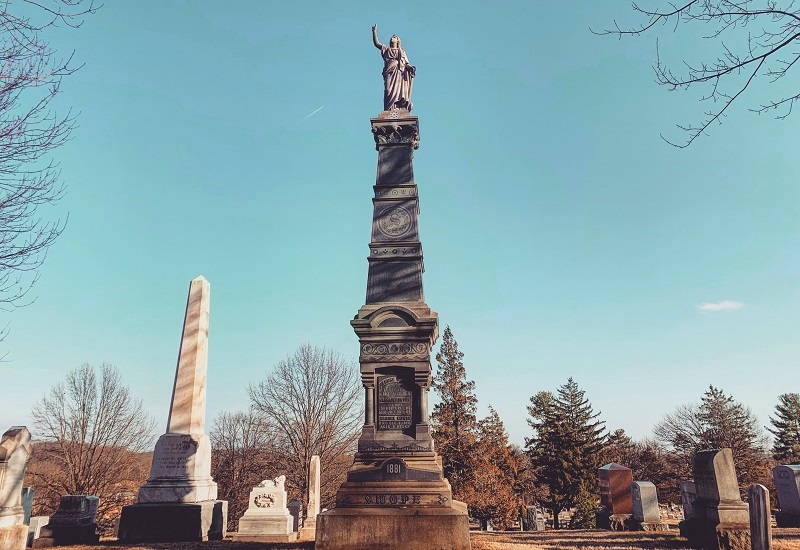
Gettysburg is a name that entered the American history in Pennsylvania during the Civil War in the 1860s. In the national park and visitor center Gettysburg National Military Park Museum and Visitor Center you can experience the battlefield where close to 50,000 lost their lives during three days of fighting in 1863.
The Battle of Gettysburg was fought 1-3 July 1863 between Robert E. Lee’s Confederate Army of the South against George G. Meade’s Union Army of the North. The battlefield was in Pennsylvania, which was part of the northern states, and the victory of the Union army ended Robert E. Lee’s invasion of the North.
Today, the battlefield of the great battle is located in the Gettysburg National Military Park, which preserves and tells the story of the area to visitors in historical perspective. On a visit, you can see the old battlefield, and you can also visit the Gettysburg Museum and Visitor Center, where you can see preserved uniforms, cannons and other weapons from the battle.
In the Gettysburg National Military Park you can also visit Gettysburg National Cemetery, which was established as a burial ground for fallen Union soldiers. In the center of the cemetery stands The Soldiers’ National Monument, and it was in the cemetery that Abraham Lincoln gave his famous ‘Gettysburg Address’ speech on November 19, 1863. The speech was given at the opening of the cemetery.

Trenton is the capital and one of the largest cities in the US state of New Jersey. Its history began when English Quakers settled here in 1679. In 1719, the town was named Trenttowne after William Trent, who had acquired much of the area’s land from the family of the first Quaker leader. Trenttowne was later shortened to the present Trenton.
In 1776, the Battle of Trenton was fought around the city, and it was George Washington’s first military victory during the American Revolutionary War. After the war, New England and several northern states wanted Trenton to be the nation’s capital, but the South demanded that the capital be located south of the Mason-Dixon line.

Allentown is a city in the state of Pennsylvania. It was founded in 1762 by William Allen, a prominent Philadelphia merchant and former mayor. Allentown was originally named Northampton Town, but later named after its founder. The city played a significant role during the American Revolutionary War, when it served as a hiding place for the Liberty Bell to protect it from British forces.
Over the years, Allentown has grown from a small colonial settlement into a busy urban center, becoming the third-largest city in Pennsylvania. In the 19th century, Allentown’s strategic location along the Lehigh River and the construction of the Lehigh Canal spurred industrial growth.

Jersey City in the state of New Jersey is a big city located just across the Hudson River from Manhattan. Jersey City has a rich history that dates back to the early 17th century when it was first settled by the Dutch. Originally known as Paulus Hook, the area played a significant role during the American Revolutionary War, serving as a strategic military post.
By the 19th century, Jersey City had transformed into a busy industrial hub, attracting immigrants from around the world, just like neighboring New York City. Throughout the 19th and 20th centuries, Jersey City continued to grow and evolve.

New York City is a metropolis, also known as the Big Apple, and it is the epitome of the United States and much of what the United States stands for in diversity, opportunities and freedom. It is an international metropolis that attracts tourists from all over the world all year round, and there is always something exciting to see and do in this, the largest American city.
Upon entering the city the Statue of Liberty stands as a symbol of the land of the free and the American dream, which has always been popular among immigrants and tourists alike. The statue goddess overlooks Manhattan’s mix of the many classic and modern skyscrapers, bridges, rivers and many other sights and features.
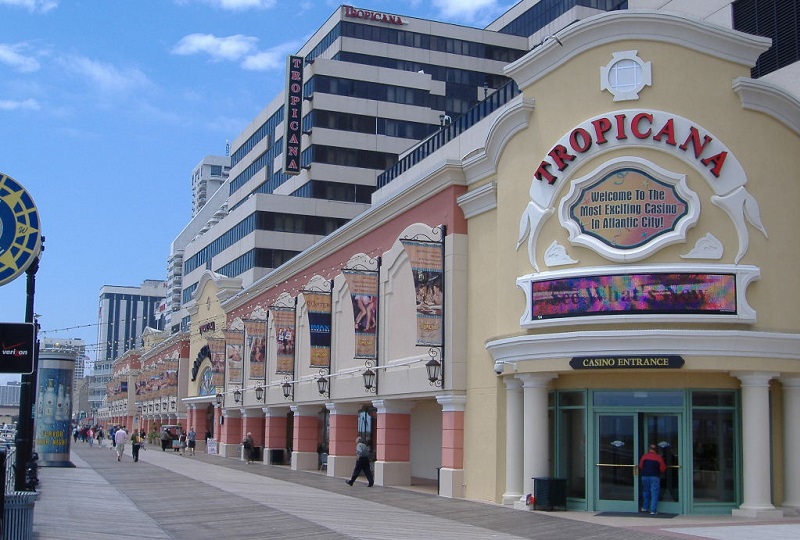
Atlantic City is a place known as a major resort city. It is located on an island with long beaches facing the Atlantic Ocean, and it is believed that there has been European settlement on the site from the mid-18th century. However, it was not until around 1850 that the town began a development towards becoming a holiday destination as it is known today.
The name Atlantic City was used from 1853, and in the same year the Belloe House opened as the city’s first major hotel. The following year, Atlantic City was connected to the city of Philadelphia by the Camden and Atlantic Railroad, and in the following decades, the number of visitors to the city exploded, and large hotels such as the Surf House and The United States Hotel were built.
The boom in Atlantic City continued in the first part of the 20th century, when large hotels were constructed along the city’s famous boardwalk at the seafront. However, the success did not last later in the century, and so the state of New Jersey allowed casinos from 1976.
Today, you can enjoy the resort city along the ocean, which is famous for The Atlantic City Boardwalk, opened already in 1870. The Atlantic City Boardwalk is miles long, and there are many activities, shops and restaurants along it. The city is also still home to several casinos that attract many tourists.
At the Atlantic City Boardwalk you can notice some of the city’s better-known sights, such as Boardwalk Hall, which opened in 1929 and which remains one of the preserved buildings from Atlantic City’s golden age. In Boardwalk Hall, the Democratic Party held its National Convention in 1964, where Lyndon Johnson was nominated as the presidential candidate.

Wilmington is the largest city in the US state of Delaware. The town’s history started in 1638, when Swedish settlers landed along today’s Christina River and established Fort Christina, the town of Christinahamn and the colony of New Sweden. In 1655, the area became Dutch and then English in 1664. In 1731, Thomas Willing designed the town with a town plan, and he called the town Willington, which was changed to Wilmington in 1739.
In the 19th century, the city grew to more than 75,000 inhabitants. Railways and streetcar lines were constructed, and industries and cultural institutions such as the Wilmington Opera were established. With its manufacturing capacity and the city’s shipyards, the world wars in the 20th century brought new growth to Wilmington, which by this time passed 100,000 inhabitants.

Harrisburg is the capital of the state of Pennsylvania. It has a history that dates back to the early 18th century. The area was originally inhabited by Native American tribes, including the Susquehannock and Shawnee. European settlement began when John Harris, Sr., an English trader, established a trading post and ferry service along the Susquehanna River around 1719.
His son, John Harris, Jr., laid out the town in 1785, naming it Harrisburg. The town briefly changed its name to Louisbourg in honor of King Louis XVI of France, but reverted to Harrisburg in 1791. Harrisburg was designated the state capital in 1812, replacing Lancaster, and the cornerstone for the new capitol building was laid in 1819.
901 Market Street
fashiondistrictphiladelphia.com
160 N Gulph Road
simon.com
1455 Franklin Mills Cir
simon.com
16th & Chestnut
shopsatliberty.com
Second Street, Third Street, Chestnut Street
Reading Terminal Market, Italian Market
The Academy of Natural Sciences of Drexel University
1900 Benjamin Franklin Parkway
ansp.org
Independence Seaport Museum
211 S Columbus Blvd
phillyseaport.org
Adventure Aquarium
1 Riverside Drive, Camden
adventureaquarium.com
Battleship New Jersey
100 Clinton Street, Camden
battleshipnewjersey.org
Philadelphia Zoo
3400 W Girard Avenue
philadelphiazoo.org
Please Touch Museum
4231 Avenue of the Republic
pleasetouchmuseum.org
Sesame Place
100 Sesame Road, Langhorne
sesameplace.com
TreeTop Quest Philly
51 Chamounix Drive
treetopquest.com
LEGOLAND Discovery Center
500 West Germantown Pike, Plymouth Meeting
legolanddiscoverycenter.com
Elmwood Park Zoo
1661 Harding Blvd, Norristown
elmwoodparkzoo.org
Camden Children’s Garden
3 Riverside Drive, Camden
 Philadelphia
Philadelphia
Overview of Philadelphia
Philadelphia is one of the historically important cities of the United States, and it was even the capital of the country in the years 1790-1800. In the town of the Delaware River, there are countless sights and lots of early American history that give intriguing impressions from the time around the American Revolution.
It was in Philadelphia that the American Declaration of Independence of Great Britain was adopted, and in that way the city has a special status in the history of the United States. This can be looked at in more detail in Independence Hall, which formed the setting for both the declaration and for the adoption of the US Constitution.
Philadelphia is also much more than early American history. In the modern city center there are some of the country’s tallest buildings outside New York and Chicago, and here are several interesting museums with everything from French Impressionists to exciting natural history.
About the Whitehorse travel guide
Contents: Tours in the city + tours in the surrounding area
Published: Released soon
Author: Stig Albeck
Publisher: Vamados.com
Language: English
About the travel guide
The Whitehorse travel guide gives you an overview of the sights and activities of the Canadian city. Read about top sights and other sights, and get a tour guide with tour suggestions and detailed descriptions of all the city’s most important churches, monuments, mansions, museums, etc.
Whitehorse is waiting for you, and at vamados.com you can also find cheap flights and great deals on hotels for your trip. You just select your travel dates and then you get flight and accommodation suggestions in and around the city.
Read more about Whitehorse and Canada
Canada Travel Guide: https://vamados.com/canada
City tourism: https://visitwhite-horse.ca
Main Page: https://www.vamados.com/
Buy the travel guide
Click the “Add to Cart” button to purchase the travel guide. After that you will come to the payment, where you enter the purchase and payment information. Upon payment of the travel guide, you will immediately receive a receipt with a link to download your purchase. You can download the travel guide immediately or use the download link in the email later.
Use the travel guide
When you buy the travel guide to Whitehorse you get the book online so you can have it on your phone, tablet or computer – and of course you can choose to print it. Use the maps and tour suggestions and you will have a good and content-rich journey.


City Hall is Philadelphia’s seat of the city government and administration. The impressive building was constructed in the years 1871-1901 in a stately Napoleon III style. The town hall tower is 167 meters high, and at the top stands a statue of the city’s founder, William Penn.
It was the architects John McArthur Jr. and Thomas U. Walter, who designed City Hall, which opened as the tallest building in Pennsylvania, which it was until 1932. In fact, City Hall was planned to be the tallest building in the world, but during construction, the Eiffel Tower and the Mole Antonelliana, among others, were completed with larger Heights.
Philadelphia City Hall was built with a beautiful decoration. In addition to the statue of the city’s founder, William Penn, the approximately 250 other sculptures are artists, engineers and others who over time contributed to the development of the United States and stood for American ideals. You can also enjoy the beautiful building and large parts of Philadelphia from the observation deck of the City Hall tower at a height of 150 meters.
The famous writer Edgar Allan Poe lived in several places in Philadelphia in the years 1837-1844. The Edgar Allan Poe National Historic Site is a museum located at 532 N. 7th Street, the only one of his residences in the city that survives today. He rented the place here from early in 1843 and he lived here for about a year.
Poe lived in at least four different places in Philadelphia, including on Arch Street, on 16th Street, and on Coates Street. While the author lived in the city, he published some of his best-known works such as The Tell-Tale Heart, The Murders in the Rue Morgue and The Gold-Bug.
At the museum you can learn about Poe’s life, contemporaries and works. You can also see a room that is decorated in the style of the 1800s. However, the room and the other furnishings in the museum have nothing to do with the residence in Edgar Allan Poe’s time.

In 1791, the US Congress voted to establish an American National Bank, and its headquarters opened in this classicist building, which was completed in 1797 as the First Bank of the United States. In the years before, the Bank of North America had functioned as a national bank, but formally the institution was not established until the resolution of 1791.
The difference between the new bank and other banks was that First Bank of the United States had to have branches in several American states. The establishment of the bank happened as part of Chancellor of the Exchequer Alexander Hamilton’s financial innovations. In addition to the national bank, the other measures were an assumption of the state’s war debt by the United States government, the establishment of a mint, and the imposition of a federal excise tax.
The First Bank of the United States was established in Philadelphia, which was the capital of the United States in the 1790s. The bank started its operations in Carpenters’ Hall, before the new bank building was completed in 1797 in the Greek style to the designs of architects Samuel Blodgett and James Hoban.
The Second Bank of the United States was a bank that President James Madison established in 1816 as America’s second national bank. The First National Bank had operated on a 20-year contract from 1791 to 1811. In the wake of the War of 1812, the federal government suffered from the disorder of an unregulated currency and a lack of fiscal stability, and the interdependence of industrialization and finance provided support to a national banking system.
The bank was housed in a new building that was completed in 1824. The architect was William Strickland, who designed several buildings inspired by classical Greece. The bank ceased its original function in 1841, and today it is used as a gallery with portraits of important people in the early United States. It is in the People of Independence exhibition, which gives an insight into the present, and here portraits by the artist Charles Willson Peale are the core of the collection.

Benjamin Franklin Bridge is a large suspension bridge that opened in 1926. It connects Philadelphia, Pennsylvania with Camden, New Jersey. The bridge is a total of 2,917 meters long, and it crosses the Delaware River with a longest span of 533 meters. The first three years of the bridge’s life span was the longest in the world.
There were already plans for a permanent connection across the Delaware River in 1818, and throughout the 19th century many proposals for various bridges appeared, but none of them were realized. In 1919, a commission was established to find a solution, and construction of the Delaware River Bridge, which changed to the current name in 1955, began in 1922.
Since opening, several connections have been established across the river from Philadelphia to southern New Jersey. You can also take the PATCO Speedline train across the water on the Benjamin Franklin Bridge, which was actually built with streetcar rails that were never used.
Parkway Central Library is a beautiful library building that opened in 1927. The building was designed by Julian Abele in Beaux-Arts style. It is the main library of Philadelphia, and there are many interesting and valuable books and manuscripts in the collection, which includes The Rare Book Department.
The Rare Book Department features Charles Dickens’ collection of first editions, personal letters and Dickens’ stuffed raven, Grip. There is also Americana, Beatrix Potter, early children’s books, works by Edgar Allan Poe and a large collection of European manuscripts from the 11th to the 16th centuries.
The Bourse Food Hall is a vibrant place of restaurants and bars in downtown Philadelphia. It is housed in the city’s former stock exchange, which was built 1893-1895. The beautiful building obviously no longer functions as a stock exchange, but instead you can enjoy the historical setting over a meal.
It was George E. Bartol who founded the stock exchange in Philadelphia in 1891, with Hamburg’s stock exchange as a model. Bartol had been inspired in Europe the year before, and he organized Philadelphia’s business life to invest in the creation of the stock exchange. After this, the stock exchange building was designed by G. W. & W. D. Hewitt and built in redstone and terracotta.
The National Constitution Center is a center and history museum whose focus is the US Constitution. The center was built from 17 September 2000 and opened on 4 July 2003, and since then various object and exhibitions have told the story of the constitution and created dialogue around it. You can visit a hall with models of the signatories of the American Constitution, who made the historic signing on September 17, 1787.
It was politically decided in 1988 to establish the center and museum to create knowledge and understanding of the US Constitution among Americans. It was also decided that the center should be located as part of the Independence National Historic Park in Philadelphia, where, together with the Independence Hall and Liberty Bell, it could form a unified center for the history of American independence.

One Liberty Observation Deck is a place on the 57th floor of the One Liberty Place building where you can enjoy a fantastic view of Philadelphia and the surrounding area. The whole city lies at your feet, and you can follow the course of the Delaware River and see the state of New Jersey.
One Liberty Place is one of two distinctive skyscrapers that together form the Liberty Place complex. One Liberty Place is 288 meters high, while its sister building Two Liberty Place is 30 meters lower. Construction took place between 1985 and 1987, and in terms of height, the high-rises were the first in the city to surpass the William Penn statue on top of Philadelphia City Hall.
Gloria Dei Church is a church also called Old Swedes’, which comes from the fact that the church was built as a Swedish church in the years 1698-1700. It is the oldest church in the state of Pennsylvania. Around the church there is a cemetery, where Sven Gunnarsson is one of those buried. Gunnarsson was a founder of New Sweden along the Delaware River in the middle of the 17th century.
After the founding of New Sweden, the Swedes built churches, The first one was Holy Trinity Church in Wilmington, Gloria Dei Church became the second Swedish church in the colony. The settlement was established in 1677, and in the first years services were held in another building that was not built as a church.
Gloria Dei Church made history in 1703 as the first place in America where a Lutheran ordination was held. It happened when Justus Falckner was ordained a priest. In the church you can see a fine interior with various decorations such as models of Fogel Grip and Kalmar Nyckel, which were the first Swedish ships that arrived to New Sweden.

Pennsylvania Academy of the Fine Arts is an art academy in Philadelphia. It is the oldest of its kind in the United States, and its museum is the oldest art museum in the country. Over the years, the museum has built up a very fine collection of American works, and you can enjoy works by Edward Hopper, Winslow Homer and Kehinde Wiley, and you can see one of Gilbert Stuart’s well-known portraits of George Washington.
The academy was founded in 1805 by, among others, the artists Charles Willson Peale and William Rush, and the museum was established two years later. The first exhibition took place in 1811, where visitors could see over 500 paintings and sculptures. Today, you can enjoy the museum’s exhibits in the Furness-Hewitt Building from 1876, which is considered one of America’s most beautiful Victorian buildings.
Comcast Technology Center is an office building with a height of 342 meters. It opened in 2018 as the tallest building in the United States outside of the two classic skyscraper cities, New York and Chicago. There are 60 floors in the high-rise, which has a hotel and a restaurant at the top, and from here there is of course a magnificent view.
It was Foster and Partners who were the main architects of the high-rise, which is described as a super-tall skyscraper, as it is over 300 meters. The construction includes five tanks of 125,000 liters of water, which are placed on the 57th floor as a countervailing force on windy days to reduce swaying of the upper part of the building.
The Wells Fargo Building is one of Pennsylvania’s classic skyscrapers from the first half of the 20th century. It was built in 1927-1928 with the name Fidelity-Philadelphia Trust Company Building at a height of 30 floors and 123 meters. It was the architectural firm Simon & Simon who designed the building in Beaux-Arts architecture.
The Wells Fargo Building is one of the numerous skyscrapers built in Philadelphia in the early decades of the 20th century. In the 1920s, among others, the Aldine Trust Building, Lewis Tower, Drake Hotel, Ben Franklin House and Rittenhouse Plaza were built, and high-rise construction continued in the 1930s with, for example, the PSFS Building from 1932, which was the first skyscraper in the USA in the international style.

30th Street Station is a large railway terminal that opened in 1933 and it serves as Philadelphia’s main train station. There are many beautiful details in the building, such as the Art Deco-style promenade and Walker Hancock’s sculpture Angel of the Resurrection, which was produced in 1952. You can also see the artwork Spirit of Transportation, which dates from 1895.
The station’s history began when the Pennsylvania Railroad acquired tunnel rights from the Schuylkill River to 15th Street in exchange for land the city needed to build the Benjamin Franklin Parkway. The exchange made it possible for the company to build both Suburban Station and 30th Street Station, which, unlike a previous railway station on the site, had continuous platforms for trains between New York and Washington.
The Franklin Institute is a scientific institution and museum with interesting exhibits in various fields of science and technology. There are both permanent exhibitions and changing themes, and then you can also see the Benjamin Franklin National Memorial with a 6 meter high marble statue of Franklin, who was one of the so-called Founding Fathers of the United States.
The institute was established in 1824, and in time the Franklin Institute Science Museum opened, which is the best-known part of the institution. At the museum you can see several themed exhibitions such as The Franklin Airshow with the Wright brothers’ Wright Model B. This is also where you can see The Giant Heart, The Train Factory and much more.

Penn Museum is an archaeological and anthropological museum belonging to The University of Pennsylvania. The forerunner was called the University of Pennsylvania Museum of Archeology and Anthropology, and it was founded in 1887 after an archaeological expedition to present-day Iraq. Over time, the university has led numerous expeditions over large parts of the world and thereby built up an interesting collection.
Over the years, the collections at the Penn Museum have expanded significantly through various purchases. You can see artifacts from East Asia, America and the Near East. Today you can visit galleries with things from the ancient world around the Mediterranean, Egypt, the Near East, Mesopotamia, East Asia and Mesoamerica. There are also artifacts from the indigenous peoples of Africa and Native America.
Boelson Cottage is a cottage built around 1680 and it stands as Philadelphia’s oldest surviving building. The cottage is located in Fairmount Park and was built in Swedish-Dutch style. The name comes from John Boelson, who was granted the plot of land here in 1677.
The cabin is located on the west bank of the Schuylkill River on the 40-acre parcel of land granted to John Boelsen by the Swedish Colonial Court in Upland, Pennsylvania. Today, the cabin is located in Fairmount Park, the largest public park in Philadelphia.
Similar to Philadelphia Travel Guide
